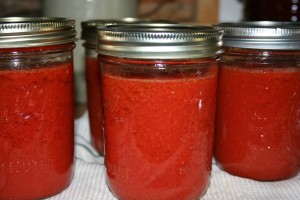Can the Tomatoes—You’ll Never Go Back
Posted in Exhibitions, The Edible Garden on July 23 2010, by Plant Talk
Demonstration Shows How to Put Up Your Own at Home
 |
Eugenia Bone is a veteran food writer and author of Well-Preserved. She will present canning demonstrations at The Edible Garden Conservatory Kitchen on July 25 at 1 and 3 p.m. |
 You may remember your grandmother putting up fruits in glass jars. Well, that practice is alive and well in New York City today, and it’s as safe and easy as it ever was.
You may remember your grandmother putting up fruits in glass jars. Well, that practice is alive and well in New York City today, and it’s as safe and easy as it ever was.
The motivation for urban and suburban canning is to have foods on hand to eat off-season (as well as for health, economic, and environmental reasons). All you have to do is decide what you’d really like to have stocked in the cupboard. People often ask me what is a good starter product for the beginner canner. I always say, whatever you like to eat! For me, that’s tomatoes. But to make it manageable, I put up a couple of pints at a time, when I am cooking dinner and hanging around the kitchen anyway.
Though tomatoes are a fruit, they have a pH usually of 4.5 or 4.6, which is just on the borderline of foods you can safely process in a water bath. For this reason, the Feds recommend you acidify all tomato products. You can use 2 tablespoons of lemon juice per pint, but I prefer a 1/4 teaspoon of citric acid. I buy 4-ounce jars of NOW citric acid online (www.nowfoods.com, keyword “citric acid”), and that does the trick of acidifying tomatoes beautifully.
I can tomatoes two ways, depending on how much time I have. My grade A canned tomatoes, with skin and seeds removed and flesh crushed, then heated and processed, takes about 20 minutes longer to prepare than my grade B tomatoes, which are raw packed and take minutes: You just shove halved tomatoes into the jars, add the citric acid, and process.
Raw pack is incredibly simple. There are two downsides, however. You have to process raw pack tomatoes about 10 minutes longer, and when it comes time to cook the tomatoes in a recipe, you’ll often want to remove those skins and seeds by pushing the tomatoes through a food mill. If you do cook recipes with tomatoes and leave the skins and seeds on, choose recipes that call for short (30 minutes and under) cooking times. That’s because the longer you cook a tomato with the skins and seeds, the more bitter it will become. (That’s why tomato sauces often call for sugar.)
From these tomatoes I make all kinds of foods, from marinara sauces to soups and stews. I also puree skinless, seedless tomatoes and cook them down to make ketchup or cook them down even further to make tomato paste, both of which can be safely canned in a water bath and will hold for a year in your pantry.
Once you’ve tasted home canned tomatoes in your dishes you’ll never go back to the store-bought stuff. Come see me demonstrate both techniques on Sunday, July 25, at 1 and 3 p.m. during The Edible Garden. After each presentation I will be signing copies of my book, Well-Preserved.


Great tips and summary of raw pack/traditional pack. Thanks for info about why citric acid is necessary!
I am learning from an Italian neighbor who puts basil leaves in each bottle. Question: Have you ever put, or do you recommend, putting tomato leaves in the bottles? Saw this note which appeared at the Good Life Garden at UC Davis — I had never heard of such a thing: http://www.yourgardenshow.com/users/walker/good-life-garden-davis-ca/slideshow/22581
Thanks for your post.